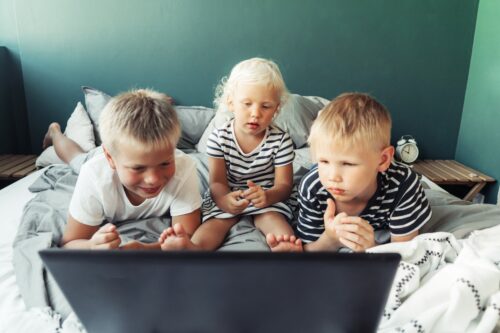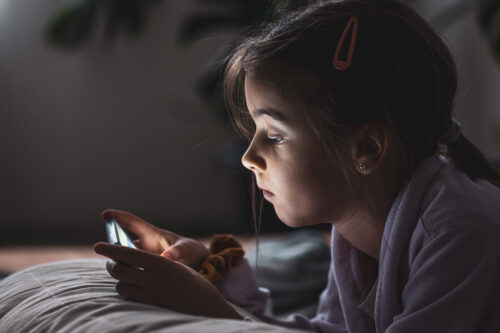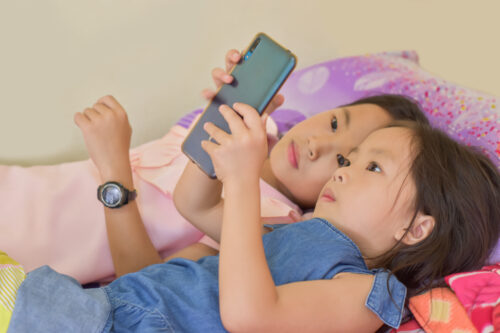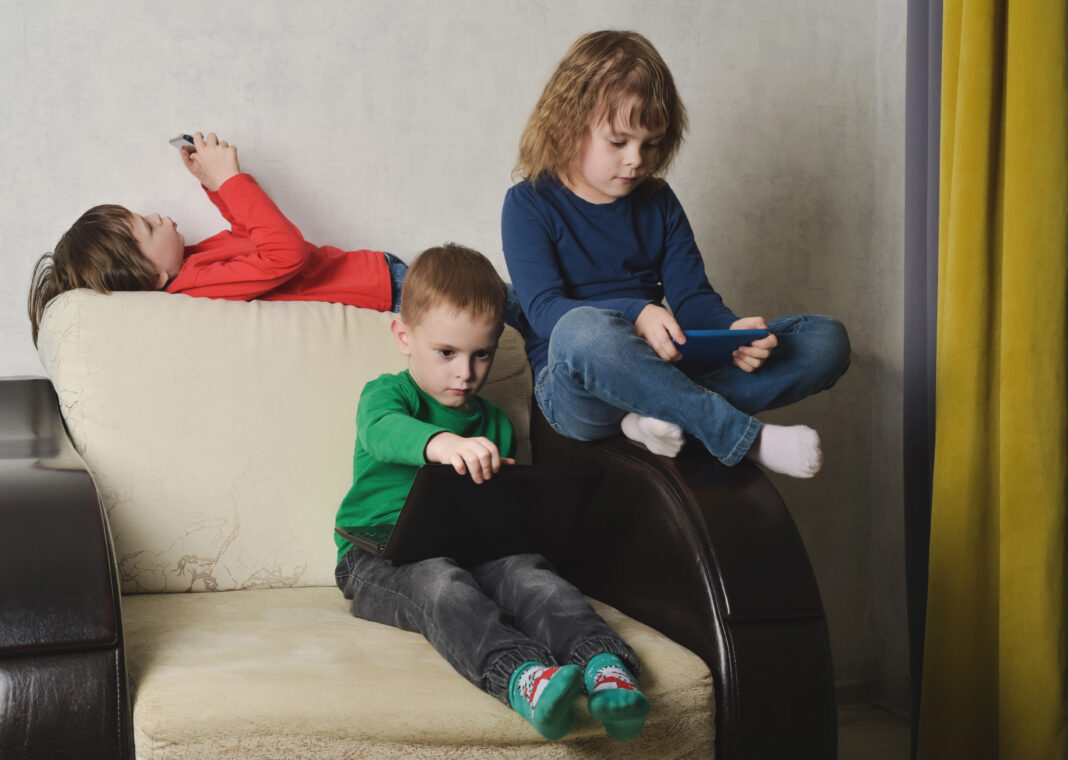Screen Time and Children: How Much Is Too Much?
One of the most common questions parents ask is “How much screen time is okay for my child?” In today’s digital world, where screens are everywhere—from TVs to tablets, smartphones, and laptops—it’s natural for parents to feel concerned about their child’s exposure to electronic devices.
Screen time can be educational and entertaining, but excessive use can affect eye health, brain development, social skills, and overall well-being. So, how do we find the right balance? In this blog, we’ll answer some of the most pressing questions about screen time and provide practical guidelines for parents.

- What Is the Recommended Screen Time for Each Age?
Experts, including the World Health Organization (WHO) and the American Academy of Pediatrics (AAP), provide the following guidelines:
🍼 0–18 months: No screen time, except for video calls with family members.
👶 18 months–2 years: Limited screen time with high-quality educational content (e.g., interactive story apps, supervised watching).
👧 2–5 years: 1 hour per day of high-quality programming, with parental involvement.
🧒 6–12 years: Up to 2 hours per day, balancing screen use with outdoor activities, playtime, and family interactions.
👦 12+ years: Screen time should be monitored to ensure a healthy balance between schoolwork, social life, and physical activity.
⚠ Important Note: These are general guidelines—every child is different, and it’s essential to observe how screen time affects their behavior, mood, and sleep.

- TV vs. Tablets: Which Is Better for Kids?
Parents often wonder if it’s better for children to watch TV or use a tablet for games and videos.
📺 TV (Big Screen)
✔ Easier on the eyes compared to small screens.
✔ Allows for shared family viewing (e.g., watching educational shows together).
✔ Less interactive than a tablet—passive viewing might not be as engaging.
📱 Tablets (Small Screen)
✔ Can be interactive (e.g., learning apps, digital drawing).
✔ Encourages independent learning but may lead to isolation if overused.
✔ Small screens cause more eye strain and can impact posture.
💡 What’s Best? If screen time is unavoidable, a TV or projector at a safe distance is better for young children than staring at a small screen up close. Interactive learning activities on a tablet are great but should be balanced with other activities.
- How Does Screen Time Affect Eye Health?
Excessive screen time can lead to:
🚩 Eye strain and fatigue.
🚩 Dry eyes (children blink less when staring at screens).
🚩 Increased risk of nearsightedness (myopia) due to prolonged close-up screen use.

💡 Tips to Protect Your Child’s Eyes:
✔ Follow the 20-20-20 Rule: Every 20 minutes, take a 20-second break, looking at something 20 feet away.
✔ Encourage outdoor play—natural sunlight helps prevent nearsightedness.
✔ Reduce small screen time (phones, tablets) and opt for larger screens when possible.
✔ Adjust brightness and avoid screens in the dark.
- Is It Okay for Kids to Have Screens While Eating?
Many parents allow screen time during meals to keep children entertained and cooperative, but this habit can lead to problems:
🚩 Mindless eating – Kids don’t learn to listen to their body’s hunger cues.
🚩 Lack of family interaction – Mealtime is an important time to connect.
🚩 Food refusal or pickiness – Kids might become dependent on screens to eat.
💡 Healthy Mealtime Alternatives:
✔ Create a screen-free meal rule for the whole family.
✔ Engage children in conversation or tell stories while eating.
✔ Let them help set the table or choose a small task to keep them engaged.
- Is Screen Time Okay on Long Car Trips?
Long drives can be challenging for children, and many parents use tablets or phones to keep them occupied. But is this harmful?
🚗 Effects of Screen Time in the Car:
✔ Screens help with boredom but limit engagement with surroundings.
✔ Small screens in moving vehicles may cause motion sickness.
✔ Extended screen time increases eye strain.
💡 Better Travel Alternatives:
✔ Audio books or music – Keeps kids entertained while encouraging imagination.
✔ Activity books, coloring, or sticker books – Great for young kids.
✔ Interactive games (I-spy, counting games, storytelling) – Keeps kids engaged without screens.
💡 If using a screen in the car:
✅ Choose a larger device (like a mounted tablet or car TV screen) rather than a small phone.
✅ Limit usage to short intervals and encourage breaks with eye rest.
- Balancing Screen Time with Outdoor Play & Social Interaction
Children need a variety of activities to develop physically, emotionally, and intellectually. Too much screen time can affect:
🚩 Social skills – Less face-to-face interaction.
🚩 Emotional development – Reduced ability to manage frustration or boredom.
🚩 Physical health – Increased risk of obesity, poor posture, and weaker motor skills.
💡 Healthy Daily Routine:
✔ Screen Time: Limited to recommended age-based guidelines.
✔ Outdoor Play: At least 1–2 hours a day for exercise and exploration.
✔ Social Activities: Playdates, family games, or storytelling.
✔ Hands-on Learning: Building blocks, puzzles, crafts, or reading.
📢 Golden Rule: If screens replace physical activity, playtime, or sleep, it’s too much.
- Setting Healthy Digital Habits for Life
Instead of banning screens entirely, the goal is to help children develop healthy digital habits.
💡 Parental Strategies for Healthy Screen Use:
✅ Be a Role Model – Kids follow what they see. Set boundaries for your own screen time too.
✅ Use Parental Controls – Ensure safe and age-appropriate content.
✅ Create Screen-Free Zones – Bedrooms, dinner tables, and play areas should be screen-free.
✅ Have Screen-Free Hours Before Bed – Blue light disrupts sleep; avoid screens 1 hour before bedtime.
✅ Encourage Creative Screen Use – Use screens for learning, creativity, and family bonding instead of passive consumption.
Final Thoughts: Finding the Right Balance
We live in a technology-driven world, and screens are a part of our daily lives. Instead of fearing them, let’s teach children how to use screens responsibly.
🌟 Key Takeaways:
✔ Screen time should be age-appropriate and balanced with outdoor play and social activities.
✔ Big screens (TVs) are better for young kids than small screens (phones, tablets).
✔ Protect eye health with screen breaks, outdoor time, and proper lighting.
✔ Avoid screens during meals to encourage mindful eating and family bonding.
✔ Car screen time is okay in moderation, but alternative entertainment is better.
✔ Encourage educational, creative, and interactive screen use instead of passive watching.
The key is balance. When managed correctly, screen time can be a positive part of childhood—just make sure it’s not replacing essential activities for physical, emotional, and cognitive development.
💬 Parents, how do you manage screen time in your home? Do you have any tips or struggles? Let’s share in the comments! 😊




